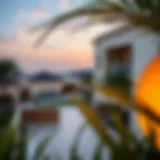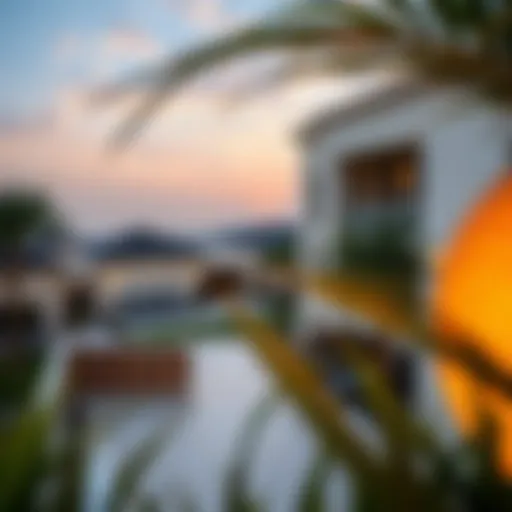Discovering Naif Souk: Tradition Meets Modernity in Dubai
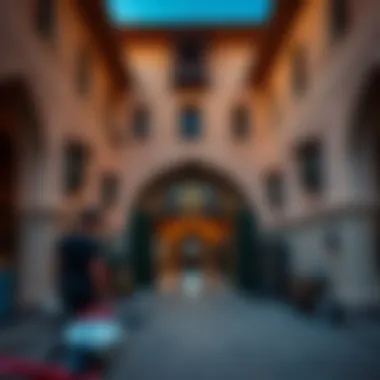

Intro
Nestled in the bustling heart of Dubai, Naif Souk stands as a symbol of the city's rich cultural tapestry melding seamlessly with modern commercial practices. This vibrant marketplace, known for its vibrant array of goods, provides visitors with a glimpse into both the storied past and the dynamic present of Dubai. Famed for its eclectic mix of traditional and contemporary shopping experiences, Naif Souk invites tourists and locals alike to explore its narrow alleyways lined with colorful shops and stalls. As you wander through the souk, the aromatic scents of spices waft through the air, mingling with the laughter and chatter of shoppers, creating an atmosphere that is as lively as it is inviting.
Naif Souk's history dates back to Dubai’s early days, serving as a trade hub that facilitated the exchange of goods between cultures. Today, it continues to thrive, showcasing various merchandise that reflects the city’s rapid growth while still honoring its roots. This article delves deep into Naif Souk’s significance, its architectural beauty, the diversity of products, and how it plays a pivotal role in local commerce and tourism. Prepare to embark on a comprehensive journey that bridges tradition and modernity, providing insight tailored to investors, agents, developers, and homeowners eager to understand this stunning marketplace.
This exploration ensures not only a full appreciation of Naif Souk's charm but also its impact on the vibrant economy of Dubai—a city known for its unique position as a melting pot of cultures and ideas.
Foreword to Naif Souk
Naif Souk, a focal point in Dubai’s bustling marketplace scene, represents not only a commercial hub but also a cultural touchstone that reflects the rich history and traditions of the city. This lively souk offers a glimpse into the past while adapting to the ever-evolving modernity surrounding it. Through its narrow pathways and effervescent stalls, one can sense a blend of the old and new, making it essential for both locals and visitors alike.
Importance of the Topic
The significance of Naif Souk stretches beyond mere shopping. It narrates a story about the community, identity, and commerce in a city that has rapidly transformed over the years. With every visit, there are layers of history and culture to unpack, presenting a rare opportunity for investors, agents, and developers to connect with the soul of Dubai.
The souk's importance is further accentuated by its strategic location, sitting close to the historic district of Dubai. This proximity not only helps sustain local businesses but also attracts tourism which contributes to economic growth within the region.
Many visitors find that Naif Souk offers a more authentic experience compared to some of the larger, more commercial shopping centers in Dubai. It’s where one can bargain for spices, textiles, and traditional handicrafts, blending economic activity with cultural engagement.
By examining Naif Souk within this article, we highlight its role in Dubai’s commercial landscape, uncovering both its historical roots and cultural significance. A deep dive into this souk reveals the ongoing dialogue between tradition and modernity, showcasing how vital this marketplace is to the city’s identity.
"Naif Souk is a living example of Dubai’s ability to blend the past with the present, creating a unique space where history informs modern business."
Through exploration and discussion, this article aims to provide enriching insights that cater directly to investors and stakeholders eager to engage with this iconic space. Understanding Naif Souk is, in many ways, understanding Dubai itself.
Architectural Features of Naif Souk
Understanding the architectural features of Naif Souk is essential for appreciating its role within Dubai's vibrant cultural and commercial tapestry. This area marries traditional designs with modern functionality, reflecting not only the historical significance of Dubai but also its forward-thinking vision. The architectural landscape here serves as a canvas for showcasing the unique fusion of old-world charm and contemporary development, inviting both locals and visitors to engage with the space in meaningful ways.
Design and Layout
The layout of Naif Souk is intentionally designed to facilitate a comprehensive shopping experience that feels organic and stimulating. Strolling through its winding pathways, one can observe an eclectic mix of stalls and shops, each showcasing products that echo Dubai's diverse culture. The market is organized in a way that encourages exploration; vendors are positioned diagonally, inviting customers to wander at leisure and discover hidden gems.
Natural light plays a pivotal role in the ambiance, as the souk features open areas allowing sunlight to filter through, lifting the spirits of the shoppers while highlighting the products. The blend of low arches and intricate wooden latticework, known as mashrabiya, enhances the aesthetic appeal while offering shade and maintaining airflow, essential in the Dubai heat. Visitors might consider how this design not only promotes comfort but also seamlessly integrates into Dubai’s architectural ethos, where history and modernity coalesce.
The layout of Naif Souk complements its marketplace nature, turning shopping into an evocative journey through time and culture.
Traditional Elements
The traditional elements found within Naif Souk are the heart and soul of the market, providing a rich backdrop that resonates with the essence of Dubai's heritage. From the wooden beams that support the ceilings to the hand-painted tiles adorning the walls, every detail tells a story of craftsmanship and tradition.
Artisans skilled in age-old techniques display their wares, including textiles, jewelry, and handmade crafts, reflecting the artistry that has flourished in this region for centuries.
- Decorative Patterns: The use of geometric designs is prevalent, mirroring Islamic art’s influence throughout the Middle East.
- Market Signs: Vintage-style signs add to the character, often written in both Arabic and English, representing the multicultural fabric of Dubai.
- Craftsmanship: Engaging with local artisans provides an authentic glimpse into the skills and dedication that go into creating each unique item.
The preservation of these elements juxtaposed against modern stalls provides a unique narrative—a dialogue between past and present that is not just seen, but felt as visitors navigate through their surroundings.
Through architectural appreciation, one can see Naif Souk not just as a marketplace, but as an experience that encapsulates the spirit of Dubai, making it a compelling destination for anyone wanting to understand this city’s layered identity.
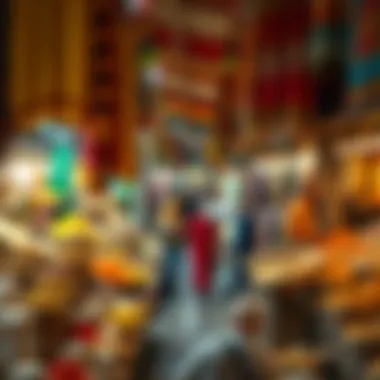

Commercial Landscape of Naif Souk
The commercial landscape of Naif Souk is as vibrant as the city it resides in. It serves not only as a marketplace but also as a historical testament to the evolution of trade in Dubai. This souk represents a fusion of traditional and modern economies, offering a diverse array of products, and it plays a significant role in the local commerce system. In this bustling hub, the blending of old-world charm with contemporary business practices reflects Dubai's ever-changing economic landscape. Shops here operate much like a family, where relationships between merchants and customers can run deep.
Types of Goods Available
One of the most captivating aspects of Naif Souk is the sheer variety of goods on offer. Visitors can find anything from traditional textiles to contemporary electronics, encapsulating what Dubai is all about.
- Textiles: Here, you can discover beautiful fabrics and garments that are often handcrafted, showcasing the cultural heritage of the region.
- Jewelry: While it may not have the glitzy offerings of the Gold Souk, Naif has unique pieces that carry their own stories, often made by local artisans.
- Perfumes: The fragrance shops in Naif Souk offer a variety of traditional Arabic perfumes, crafted using ancient methods that appeal to both locals and tourists alike.
- Spices and Dried Fruits: An aromatic journey awaits you in the spice shops, where vendors share both the flavors and the stories behind their products.
For those who are looking to buy in bulk, many merchants offer significant discounts to retailers, making it attractive for buyers at all levels. Here, haggling is not just accepted but expected, adding a playful element to the shopping experience.
"Shopping at Naif Souk is like peeling an onion – every layer exposes a new treasure, waiting to delight and surprise you."
Local Artisans and Merchants
The heart of Naif Souk undoubtedly pulses with the dedication of local artisans and merchants. Many of these individuals have inherited their craftsmanship from generations before them, and it shows in the quality of their goods.
- Artisans: Local artisans showcase their work in dedicated booths or small shops, offering genuinely unique items that reflect their skills. For example, a local carpet maker may craft intricate patterns that tell a story rooted in tradition.
- Merchants: The merchants here don’t merely sell products; they sell experiences. Many have rich histories and are more than happy to share tales of their families and the origins of the items they sell.
To many locals, supporting these small businesses goes beyond a transaction; it’s about sustaining culture and tradition in a rapidly modernizing world. In spite of the encroaching modernity, Naif Souk remains a sanctuary where local businesses thrive—exemplifying resilience amidst change. Customers looking for genuine experiences often find that the interactions with these artisans turn a simple purchase into a cherished memory.
As Naif Souk continues to embrace the dynamics of traditional commerce while integrating modern sensibilities, it promises not just a shopping trip, but an engagement with Dubai's soul.
Visitor Experience at Naif Souk
Visiting Naif Souk offers more than just another shopping trip; it’s an immersion into a bustling world where the traditional and modern elegantly intertwine. For tourists, this experience is not just about purchasing goods, but about feeling the pulse of Dubai's vibrant culture.
Naif Souk stands as a testament to the city’s history and its relentless pursuit of development. When walking through its winding paths, visitors will find an array of shops selling everything from textiles and spices to souvenirs and traditional handicrafts. This rich variety enhances the shopping experience, making each visit uniquely captivating.
Moreover, Naif Souk is easily accessible, allowing visitors to plunge into the immediate local atmosphere. The fusion of sights, sounds, and even smells intertwines to form an unforgettable sensory experience.
Navigating the Souk
Navigating Naif Souk can be likened to exploring a maze, filled with both familiar and surprising corners. To make the most of this adventure, it’s essential to adopt a few practical approaches:
- Follow the Signs: There are directional signs present throughout the souk, making it easier to find particular sections. Interpretation of Arabic signs can be delightful or confusing, so having a translation app on hand can be beneficial.
- Ask the Locals: Don't hesitate to engage with local shopkeepers. They're often more than willing to provide directions or share insights about their products, enriching the experience.
- Timing is Key: Visit early in the morning or later in the evening to avoid the peak foot traffic. The quieter hours afford you the luxury to explore without haste.
- Stay Open-Minded: Little nooks and alleyways may hide fascinating finds that might not have been on your radar initially.
Shopping Tips
Shopping at Naif Souk can be a gratifying experience, especially for those who appreciate the art of negotiation. Here are some handy tips to enhance your visit:
- Bargain Wisely: Bargaining is expected. Embrace it as part of the culture. Start by offering a price lower than what you are willing to pay, but ensure it’s reasonable, or risk offending the seller.
- Examine Goods: Take the time to inspect items carefully. This applies especially to textiles and handmade goods, as quality can vary significantly.
- Stay Hydrated: Remember that Dubai can get quite hot, especially during the day. There are many cafes and small eateries around where you can stop to rest and recharge.
- Be Mindful of Bags: As you accumulate your treasures, consider carrying a light, foldable shopping bag. This is not only practical but can also prevent you from struggling under the weight of your newfound wares.
- Cultural Gifts: Invest in traditional items as they make for great souvenirs. Items such as authentic spices, perfumes, and handcrafted jewelry will be a reminder of your time spent in this cultural haven.
By delving into the unique shopping atmosphere, and experiencing the interplay of old and new, visitors to Naif Souk are bound to take home more than just material goods; they will also carry memories and stories woven into the fabric of the souk itself.
Culinary Delights in Naif Souk
The culinary landscape of Naif Souk offers a tantalizing glimpse into Dubai's rich food heritage, blending age-old recipes with modern twists. Food is more than just sustenance here; it is a vibrant thread that connects tradition to contemporary culture. For visitors and locals alike, Naif Souk stands as a testament to the multifaceted nature of Dubai's gastronomic identity. In this bustling market, the scent of spices, the sizzle of street food, and the laughter of friends sharing meals encapsulate the essence of communal dining.
Traditional Foods and Snacks
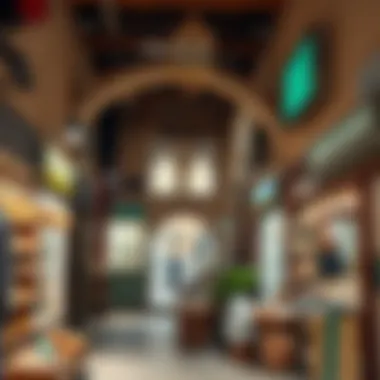

Naif Souk is a treasure trove for anyone eager to indulge in traditional Arabian flavors. Spice traders proudly display their vibrant goods, from fragrant cardamom to fiery chili powder, creating a sensory journey through spice-scented stalls.
- The samosas, crispy pastry pockets filled with spiced potatoes or meat, are a must-try. They're perfect for a quick snack while exploring the market.
- Kebab stalls serve juicy, charcoal-grilled skewers infused with herbs and spices that can transport your taste buds straight to the Middle East.
- Falafel, made from grounded chickpeas, offers a delightful vegetarian option. Studded with fragrant herbs, these morsels are often served with tangy tahini sauce.
Visiting Naif Souk without experiencing its dates would be like a fish out of water. These sweet fruits come in various types, each boasting unique textures and flavors. Savor them plain, or try them stuffed with nuts for a delightful twist.
"The culinary experiences here are like a flavorful tapestry, integrating history and culture into every bite."
Cafes and Eateries
If you're looking to unwind after your bustling shopping spree, Naif Souk is home to several cafes and eateries that cater to a variety of tastes. Here, modern cafes coexist with classic eateries, each establishing a unique atmosphere.
- Arabic coffee shops offer a cozy retreat, where you can sip on aromatic coffee served in little cups. Pair it with baklava, a sweet pastry layered with nuts, for an authentic experience.
- Some establishments include modern eateries that elevate traditional dishes with a contemporary flair. These places often experiment with fusion cuisine, combining global culinary influences with local recipes.
A visit to Naif Souk isn’t complete without stepping into these inviting spaces, where chatter fills the air and diverse menus cater to different palates. One can find everything from quick bites to leisurely meals, making it an ideal spot for both families and solo travelers.
The blend of eating options offers insight into the broader narrative of Dubai's culture: a fusion of the old and the new, where every meal tells a story.
As you explore Naif Souk, allow your senses to guide you through the culinary wonders. From spices to street food, the flavors here are a testament to the rich heritage that exists in every corner of this dynamic city.
For more information about Dubai's food culture, you can visit Wikipedia and Britannica.
The Role of Naif Souk in Dubai’s Economy
Naif Souk holds a vital place within the economic framework of Dubai, illustrating how traditional commerce can coexist and flourish alongside modern business practices. Its history and evolution speak volumes about the intricate interplay between culture and commerce in the emirate. As this bustling marketplace evolves, it takes on new roles while retaining its significance, serving as a case study in how local economies can thrive through a blend of old and new.
Impact on Local Business
The local economy reaps numerous benefits from Naif Souk. For starters, this bustling market is a hotbed for small businesses and artisans, providing them a platform to showcase their crafts and goods. Many shops here have been passed down through generations, maintaining a sense of continuity that resonates with both locals and visitors.
- Economic Vitality: Local businesses benefit from foot traffic as Naif Souk attracts tourists and residents alike, creating a lively shopping environment. This traffic helps boost sales and allows businesses to reach a wider audience than they might otherwise.
- Support for Artisans: Small vendors often provide unique, handcrafted items that are not available in larger retail chains. This not only boosts the local economy but preserves cultural practices and traditional craftsmanship, ensuring that these skills are passed on.
- Job Creation: As these businesses thrive, they create job opportunities for locals, ranging from sales positions to skilled artisan roles. This contributes to community wellbeing and economic resilience.
Tourism and Economic Growth
The synergy between Naif Souk and tourism is undeniable, with many visitors keen to dive into the authentic cultural experiences that the souk offers. The interplay between tourism and the local economy creates a powerful engine for growth.
- Attraction for Tourists: Visitors often seek out authentic experiences, searching for unique crafts, foods, and the vibrant atmosphere of a traditional souk. Naif Souk provides just that, often serving as a first stop for those eager to explore Dubai's heritage.
- Cultural Insight: Tourists gain exposure to the local culture through engagement with shop owners and artisans. This connection fosters a sense of appreciation, encouraging them to support local businesses during their stay.
- Economic Spillover: Increased foot traffic to Naif Souk also benefits nearby restaurants and hotels, creating a ripple effect within the broader economy. Visitors drawn to the souk are likely to spend at surrounding businesses, enhancing the local economy.
"Naif Souk is not just a shopping destination; it is a living museum of cultural heritage and modern economic resilience."
Naif Souk and Modern Development
Naif Souk stands as an emblem of tradition nestled within a rapidly changing urban landscape in Dubai. This marketplace is not just a bustling hub for shoppers; it reflects the delicate balance of preserving cultural identity while embracing modernity. As Dubai continues to evolve, the role of Naif Souk in this development narrative becomes increasingly significant, particularly in terms of how its historical roots are woven into the fabric of contemporary urban planning.
Preservation of Tradition Amidst Change
The preservation of tradition at Naif Souk reflects a respect for the past that is often lacking in rapid modernization efforts. As high-rise buildings and luxury malls encroach upon traditional spaces, Naif Souk has managed to hold onto its character. The souk maintains traditional architecture, with its narrow walkways and wooden vendor stalls that tell stories of generations past. The challenge lies in safeguarding this heritage while adapting to current consumer demands.
- Cultural Events: The souk regularly hosts cultural activities that highlight local customs, encouraging community involvement and preserving traditions.
- Craftsmanship: Local artisans continue to practice their crafts, such as weaving and metalwork, ensuring these skills are not lost in the shifting sands of modernity.
- Community Engagement: Local residents and visitors alike often participate in festivals and fairs that celebrate Emirati heritage, fostering a sense of belonging amid changing times.
In essence, maintaining these traditional elements nurtures a unique charm that attracts both locals and tourists. It has become a sanctuary of sorts for those longing for an authentic Emirati experience in a city characterized by its futuristic aspirations.
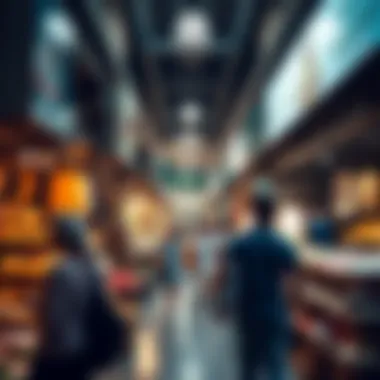

Integration with Dubai’s Urban Plans
The integration of Naif Souk with Dubai's urban plans reflects a forward-thinking approach that recognizes the importance of mixed-use developments. Rather than relegating the souk to a mere relic of the past, urban planners are incorporating this space as a vital part of Dubai's cultural landscape.
- Strategic Location: Naif Souk’s positioning within central Dubai makes it accessible, serving as a mediator between the old and the new, allowing foot traffic from modern developments to flow into its traditional aisles.
- Urban Connectivity: Projects to improve public transport and pedestrian access have been initiated, linking the souk to other major attractions, thereby enhancing its visibility and footfall.
- Sustainability Initiatives: Efforts to promote eco-friendly practices within the marketplace are also noticeable. Initiatives to encourage sustainable businesses, such as organic food options, have been encouraged to align with Dubai’s broader environmental goals.
The vision of urban planners is not just about architectural prowess but about creating vibrant public spaces that respect history while supporting growth. As Naif Souk continues to blend into Dubai’s evolving urban tapestry, it remains a critical touchstone, illustrating how heritage and modernity can coexist harmoniously.
"The essence of Naif Souk is not merely its products or the architecture; it’s the stories and lives that unfold within its lanes, reminding us that every change can hold a piece of the past."
As we look toward the future, the evolution of Naif Souk will serve as a model for how cultural sites can adapt without losing their soul. The ongoing dialogue between tradition and modern development paves the way for a vibrant marketplace that honors its roots while appealing to future generations.
Comparative Analysis with Other Souks
Comparing Naif Souk with other souks in Dubai is pivotal for understanding its unique charm and character amidst a bustling marketplace. Each souk has its essence, reflecting varied traditions and economic impacts. This exploration reveals how Naif Souk stands apart in its commitment to preserving heritage while embracing modernity.
Differences with Souk Madinat Jumeirah
Souk Madinat Jumeirah offers a stark contrast to Naif Souk, embodying a more upscale, resort-like atmosphere. Here are key elements highlighting their differences:
- Ambience: Souk Madinat Jumeirah is designed to evoke a luxurious experience, with winding waterways, plush surroundings, and high-end brands. Naif Souk, however, retains its authentic vibe, focused more on the experience of a traditional market.
- Product Range: While both souks feature an array of products, Souk Madinat leans heavily towards luxury items and designer brands, providing a range of artisanal crafts in a polished environment. Naif Souk thrives on accessible local goods, traditional textiles, spices, and handicrafts, attracting a diverse clientele from tourists to locals alike.
- Cultural Experience: Visiting Souk Madinat offers a taste of modern architecture and an artificial charm designed to cater to foreigners, whereas Naif Souk is a genuine extension of Dubai's culture where the old-world charm resonates through its narrow alleys and traditional merchant stalls.
Souk Madinat Jumeirah can be viewed as a controlled simulation of tradition, while Naif Souk embodies authentic cultural narratives.
Contrasts with Gold and Spice Souks
When comparing Naif Souk with the Gold and Spice Souks, the distinctions arise largely from purpose and product focus:
- Market Specialization: The Gold Souk is renowned for its dazzling displays of golden jewelry—an attraction pulling both seasoned investors and curious tourists looking for the best deals in gold. The Spice Souk captivates the senses with vibrant colors and scents of spices from around the globe. In contrast, Naif Souk is a melting pot, integrating various goods, from textiles to jewelry, and household items, allowing visitors to experience a wide spectrum of Dubai’s offerings in one location.
- Tourist Interaction: The Gold and Spice Souks serve more as designated places of shopping, catering heavily to tourists looking for specific items, while Naif Souk fosters interactions between local vendors and customers. Its layout encourages personal connections, where haggling is both common and expected, adding a level of engagement not typically found in the more commercialized counterparts.
- Atmosphere and Layout: The atmosphere in the Gold and Spice Souks is often buzzing with activity, but it tends to be more focused due to the nature of the products sold. Naif Souk’s layout encourages exploration; it feels more organic with its winding pathways and unexpected shops, allowing for spontaneous discoveries.
This mixture of products, local artisans, and a genuine marketplace experience makes Naif Souk an indispensable part of Dubai’s cultural tapestry.
Assessing the Future of Naif Souk
As Dubai continues to forge its path as a global hub of business and tourism, the future of Naif Souk emerges as a critical focal point. This popular market, steeped in history yet buzzing with modern energy, represents not only the heritage of the city but also its forward-looking aspirations. The interplay between tradition and modernity is a nuanced dance, and understanding the future of Naif Souk offers insights into broader trends in Dubai’s marketplace. The evolving landscape presents both potential hurdles and golden opportunities.
Potential Challenges
The road ahead for Naif Souk is not devoid of obstacles. One major challenge lies in the competition posed by newly developed shopping centers. For instance, malls like The Dubai Mall and Mall of the Emirates offer a starkly different shopping experience—air-conditioned spaces with an array of international brands, which can draw shoppers away from traditional markets.
Another prominent issue involves urbanization. As Dubai’s skyline changes, with soaring skyscrapers and expansive infrastructure projects, there's a risk that traditional marketplaces like Naif Souk may be overshadowed. Plus, rising rental prices pose a threat to small, local vendors struggling to keep up with the costs. When valued artisans and shops shut down due to financial pressures, not only is the soul of the souk compromised, but the cultural tapestry of the community gets frayed as well.
Furthermore, with the increase in tourism, there’s a double-edged sword; while more foot traffic can mean higher sales, the overcommercialization of the souk may dilute its authenticity. Visitors might seek out genuine cultural experiences, but they also risk encountering overly commercial environments that feel manufactured, losing the charm that initially drew them there.
"The essence of a marketplace lies in its authenticity. Maintain the traditional fabric while being adaptable to change is key for longevity."
Opportunities for Growth
Yet, for every challenge, there are invigorating opportunities on the horizon. The growing interest in cultural tourism presents a unique chance for Naif Souk to thrive. As more visitors search for immersive experiences that celebrate local traditions, the souk can position itself as a vital artery for discovering the cultural heartbeat of Dubai.
A strategic marketing campaign promoting Naif Souk as a must-visit destination can attract not only tourists but also local residents looking to engage with their roots. Special events, like cultural festivals or artisan showcases, could breathe fresh life into the souk and encourage community participation.
Additionally, the rise of e-commerce doesn’t spell doom for Naif Souk. Instead, it can lead to innovative ways for businesses to connect with a broader audience. Vendors can leverage social media platforms and online marketplaces to showcase their goods. Combining the online presence with in-person shopping could create a well-rounded experience that appeals to tech-savvy consumers who also crave physical interactions.
Moreover, improving the infrastructure around Naif Souk could enhance the overall visitor experience. Better access via public transport, enhanced pedestrian spaces, and updated facilities can make the souk more inviting. These improvements can ultimately lead to increased foot traffic and, consequently, higher sales for merchants.
The future of Naif Souk will largely rely on how well it can preserve its traditional roots while simultaneously embracing modern trends. By addressing its challenges head-on and capitalizing on myriad growth opportunities, Naif Souk can secure its position as a vibrant marketplace blending the old with the new.






